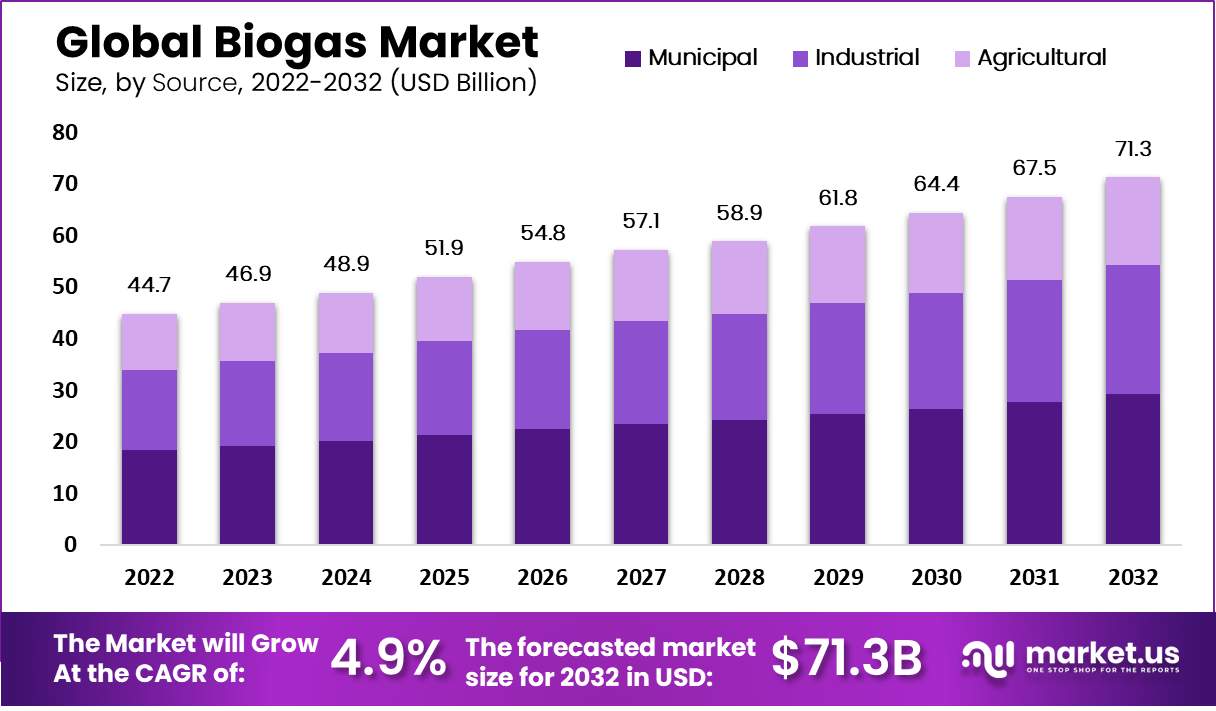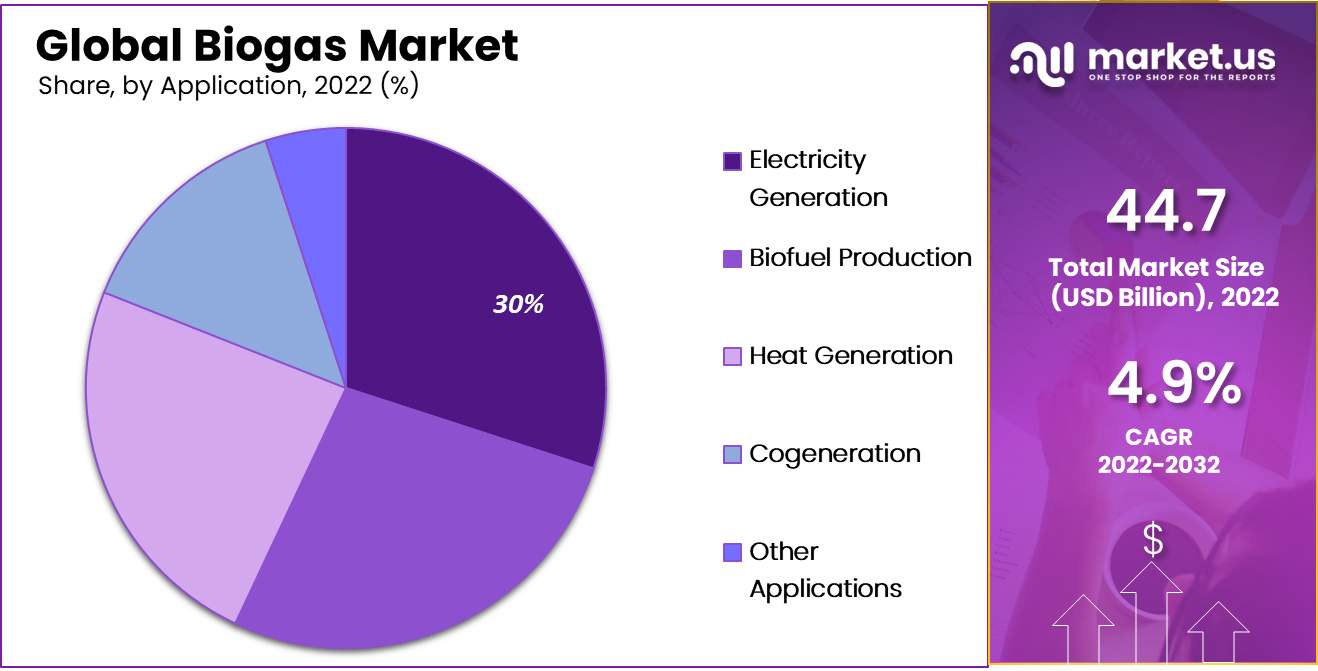Table of Contents
Introduction
According to Biogas Statistics, Biogas, seen as an eco-friendly energy choice, results from the breakdown of organic matter without oxygen, releasing methane and carbon dioxide. This process, termed anaerobic digestion, utilizes various sources like agricultural leftovers, food scraps, and animal waste.
Once collected, biogas is refined and can generate electricity, heat, or power vehicles. Its advantages include effective waste management, decreased emissions, and enhanced energy independence.
Despite challenges such as ensuring a steady supply of raw materials and building necessary infrastructure, biogas remains a promising solution for sustainable energy needs. Continuous progress and supportive policies are crucial for its widespread adoption.
Editor’s Choice
- The global biogas market revenue will exceed USD 70 billion by 2032.
- In 2022, municipal revenue accounted for USD 18.3 billion of the total biogas market revenue of USD 44.7 billion.
- Among applications, electricity generation holds the largest market share, accounting for 30% of the total market.
- Biogas generated from household waste typically contains 50–60% CH4 and 38–34% CO2, while sludge-derived biogas may have a higher CH4 content ranging from 60–75% and a lower CO2 percentage of 33–19%.
- Global biogas production reached 1.46 exajoules by the close of 2020.
- Europe emerged as the leading producer, contributing 776,905 terajoules (TJ) or approximately 20 billion cubic meters (bcm) of biogas to the global supply.
- The Advanced biodigester had a capital cost of 7.3 USD/Mbtu and maintenance/operating costs of 0.6 USD/Mbtu in 2018.

Global Biogas Market Overview
Biogas Market Size
- The revenue of the global biogas market has shown a consistent upward trend over the years at a CAGR of 4.9%, with steady growth projected into the foreseeable future.
- In 2022, the market revenue stood at USD 44.7 billion, which increased to USD 46.9 billion in 2023, reflecting a positive trajectory.
- The market is expected to maintain upward momentum, surpassing USD 60 billion by 2029 and USD 67.5 billion by 2031.
- Projections indicate robust growth prospects, with revenue anticipated to exceed USD 70 billion by 2032, reflecting biogas solutions’ increasing significance and global adoption.

Global Biogas Market Size – By Source
- Analysis reveals that the municipal sector commands a significant portion of the market, consistently contributing substantial yearly revenue.
- In 2022, municipal revenue accounted for USD 18.3 billion of the total biogas market revenue of USD 44.7 billion.
- Over the following years, this sector continued to expand, reaching USD 29.2 billion by 2032.
- Similarly, the industrial and agricultural segments also play pivotal roles in driving market growth.
- Starting at USD 15.6 billion in 2022, industrial revenue climbed steadily to USD 24.9 billion by 2032, while agricultural revenue increased from USD 10.7 billion to USD 17.1 billion during the same period.

Global Biogas Market Share – By Application
- The global biogas market is segmented by application, with various sectors contributing to its overall composition.
- Among these, electricity generation holds the largest market share, accounting for 30%.
- Fuel production is closely behind, capturing 27% of the market share.
- Heat generation represents another significant portion, comprising 24% of the market, while cogeneration accounts for 14%.
- Other applications, which encompass a range of uses beyond the primary categories, make up the remaining 5% of the market share.

Biogas Composition
- The composition of biogas varies depending on the raw materials used in its generation.
- Household waste, sludge, agricultural residues, and agri-food industry waste are familiar sources, each contributing distinct proportions of methane (CH4), carbon dioxide (CO2), nitrogen (N2), oxygen (O2), and water vapor (H2O).
- For instance, biogas generated from household waste typically contains 50–60% CH4 and 38–34% CO2, while sludge-derived biogas may have a higher CH4 content ranging from 60–75% and a lower CO2 percentage of 33–19%.
- Similarly, agricultural residues and agri-food industry waste yield biogas compositions with CH4 levels ranging from 60–75% and 68%, respectively, with varying CO2 concentrations.
Global Biogas Production
- The production of biogas has steadily increased over the past two decades, showcasing a notable upward trajectory.
- Beginning at 0.29 exajoules in 2000, the production gradually rose, reaching 0.54 exajoules by 2005.
- This momentum continued unabated, as evidenced by the consecutive annual increments: 1.35 exajoules in 2016, 1.38 exajoules in 2017, and 1.41 exajoules in 2018.
- The upward trend persisted, culminating in a production figure of 1.43 exajoules in 2019 and reaching 1.46 exajoules by the close of 2020.

Biogas Production Volume – By Continent
- In 2020, biogas supply across continents exhibited significant variations in production volumes, reflecting diverse regional dynamics and levels of adoption.
- Europe emerged as the leading producer, contributing 776,905 terajoules (TJ) or approximately 20 billion cubic meters (bcm) of biogas to the global supply.
- Following closely behind, Asia accounted for 469,175 TJ (12 bcm), showcasing a notable presence in the market.
- The Americas also demonstrated considerable production levels, generating 192,243 TJ (5 bcm) of biogas during the same period.
- In contrast, Oceania’s contribution was comparatively modest, producing 20,093 TJ (1 bcm).

Global Biogas Demand for Direct Use
- In the Stated Policies Scenario, from 2030 to 2040, global demand for biogas for direct use exhibits a notable upward trend across regions.
- Europe leads the demand, with anticipated percentages rising from 19.3% in 2030 to 21.2% by 2040, reflecting the region’s commitment to renewable energy sources and sustainability initiatives.
- China and India also show substantial growth in demand, with China’s expected percentage increasing from 8.8% to 12.8% and India’s from 1.6% to 3%, respectively, highlighting the significant contributions of these populous nations to the market.
- Other developing nations in Asia are projected to experience a substantial surge in demand, from 7.3% to 15.1%, indicating increasing adoption and investment in biogas infrastructure and technologies across the region.
- North America and the Rest of the World also demonstrate steady growth, with demand percentages rising from 4.8% to 5.7% and 5.9% to 11.3%, respectively.

Consumption Rates of Biogas Across Various Devices
- The consumption rates of biogas vary significantly across a range of devices, highlighting the versatility of this renewable energy source.
- For household burners, consumption typically falls between 200 and 450 liters per hour (L/h), catering to domestic cooking and heating needs.
- In industrial settings, burners require larger quantities, with consumption rates ranging from 1000 to 3000 L/h, reflecting the higher energy demands of manufacturing processes.
- Depending on their size and outside temperature, refrigerators consume at a rate of 30 to 75 L/h, ensuring efficient cooling operations.
- Gas lamps, equivalent to 60-watt bulbs, consume at a moderate rate of 120 to 150 L/h, providing illumination with minimal environmental impact.
- Biogas/diesel engines, commonly used in transportation and power generation, require 420 L/h per brake horsepower (bhp) for efficient operation.

Cost of Biogas Production Technologies
On a Commercial Scale
- In 2018, the average costs of biogas production technologies per unit of energy produced, excluding feedstock expenses, varied across different facilities operating on a commercial scale.
- Small biodigesters had a capital cost of 8.8 USD/Mbtu and maintenance/operating costs of 7.7 USD/Mbtu.
- In comparison, medium and large biodigesters offered more cost-effective solutions with capital costs of 6.9 USD/Mbtu and 5.2 USD/Mbtu, respectively, and maintenance/operating costs of 5.9 USD/Mbtu and 4.1 USD/Mbtu, respectively.
- Wastewater digesters, another production technology, had a capital cost of 10.3 USD/Mbtu and maintenance/operating costs of 4.3 USD/Mbtu.
- Additionally, landfill gas recovery systems emerged as the most cost-efficient option, with a minimal capital cost of 0.8 USD/Mbtu and maintenance/operating costs of 1.6 USD/Mbtu, highlighting their economic viability for biogas production on a commercial scale.

On a Household Scale
- In 2018, average costs for biogas production technologies on a household scale, excluding feedstock expenses, varied between different facilities.
- Two main types of biodigesters, categorized as “Advanced” and “Basic,” were available for household use.
- The Advanced biodigester had a capital cost of 7.3 USD/Mbtu and maintenance/operating costs of 0.6 USD/Mbtu.
- In contrast, the Basic biodigester offered a more cost-effective solution with a lower capital cost of 2.7 USD/Mbtu and maintenance/operating costs of 0.4 USD/Mbtu.

Successful Biogas Projects
R. S. Dairy Farm, V.P.O.
- In April 2012, R. S. Dairy Farm, located in V.P.O. – Bahadurpur, District – Ropar, Punjab, initiated a biogas project aimed at supplying biogas to 75 households within the village.
- The project, implemented for 15.00 lakh rupees, was solely financed by Dilbar Singh, the proprietor of the dairy farm, as it did not receive any central financial assistance from the Ministry of New and Renewable Energy (MNRE).
- With 150 cattle available on the dairy farm, approximately 3000 kilograms of dung were collected daily to fuel the biogas production process.
Tongeren
- The biogas plant in Tongeren is a pioneering endeavor within the province of Limburg, representing one of the most expansive projects in Belgium.
- Situated within the industrial precinct of Tongeren, this facility is engineered to process maize silage, constituting 80% of its feedstock, alongside industrial residues like glycerine from biodiesel production and various organic waste materials, comprising the remaining 20%.
- To uphold robust sustainability standards and achieve an annual energy crop output of 35,000 tons, local farmers have been enlisted to supply maize sourced within a 20-kilometer radius of the plant.
Oudon Biogaz Plant
- Oudon Biogaz aims to manage the significant volume of manure, exceeding 140,000 tons, generated by its 72 farms sustainably.
- Approximately 85% comprises agricultural by-products like slurry, manure, and straw. The goal is to convert these resources into 55 GWh of biomethane annually, enough to power 9,000 families in the Craon area.
- By injecting the biogas into the national grid, the project aims to prevent around 14,000 tons of CO2 emissions, equivalent to 5,500 cars annually.
Indonesia Domestic Biogas Program (IDBP)
- The Indonesia Domestic Biogas Program (IDBP) is a collaborative initiative promoting renewable energy by installing small-scale household biodigester systems known as Biogas Rumah (BIRU) across approximately 11 provinces since its inception in 2009.
- The primary objective of the IDBP is to stimulate the market for domestic biogas.
- As of the conclusion of 2019, the program has successfully established approximately 24,767 units of BIRU across households, varying in scale from 4 m3 to 12 m3.
Microferm
- Microferm is an anaerobic digestion (AD) technology developed by HoSt specifically for farmers seeking to manage manure efficiently.
- With electrical capacities ranging from 60 to 150 kW, Microferm generates electricity and heat.
- The project benefits from the Dutch SDE+ subsidy, providing a fixed fee per Nm3 of biomethane for 12 years.
Discuss your needs with our analyst
Please share your requirements with more details so our analyst can check if they can solve your problem(s)



